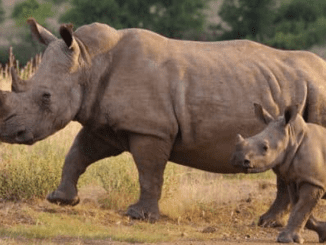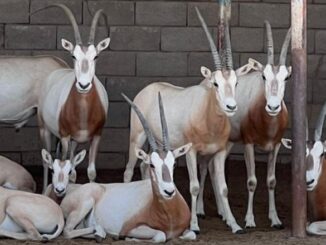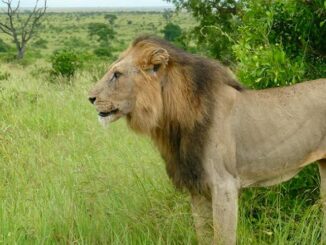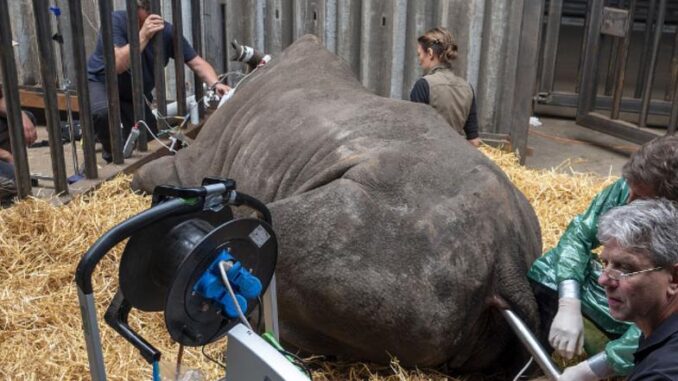
BERLIN, Germany, February 8, 2024 (ENS) – For the first time, a rhinoceros has successfully become pregnant following embryo transfer. Although the surrogate mother rhino died before she could give birth to the transferred calf, scientists say the successful embryo implantation paves the way for use of the same method to save the entire northern white rhino subspecies from extinction.
There are only two northern white rhinos remaining in the world. The adult female Najin and her daughter Fatu live in Kenya, at the Ol Pejeta Conservancy, situated on the equator west of Nanyuki, between the foothills of the Aberdares and Mount Kenya.
In an attempt to save the subspecies, the international BioRescue consortium, which includes the Max Delbrück Center for Molecular Medicine in Berlin, has created 30 northern white rhino embryos. They are stored in liquid nitrogen at minus 196 degrees Celsius in Berlin and in Cremona, Italy.
The northern white rhino embryos are awaiting transfer to surrogate mothers of the southern white rhino subspecies.
But before this transfer can go forward the team had to demonstrate that their embryo transfer concept works in white rhinos.
The project, funded with six million euros by the Federal Ministry of Education and Research since 2019, combines reproductive and stem cell technologies.
On September 24, 2023, the BioRescue scientists and veterinarians, led by the Leibniz Institute for Zoo and Wildlife Research (Leibniz-IZW), transferred two southern white rhino embryos into Curra, a southern white rhinoceros selected as a surrogate mother.
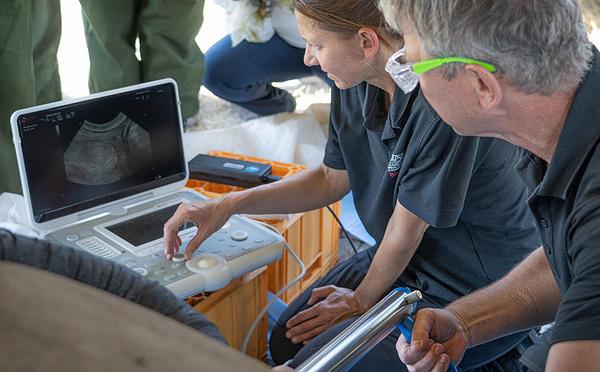
The eggs came from Elenore, a southern white rhinoceros living in the Pairi Daiza Zoo in Belgium, and the sperm used for fertilization came from the male southern white rhinoceros Athos from the Salzburg Zoo in Hellbrunn, Austria.
The eggs from Elenore were fertilized in vitro by intracytoplasmic sperm injection and developed into blastoscysts at Avantea‘s laboratories in Cremona, Italy.
Previously, embryo transfer, a widely used technique in domestic species, had never been attempted in rhinos. BioRescue scientists developed the successful techniques by building on decades of their own research. To date, the BioRescue team has performed 13 embryo transfers in rhinoceroses, three in Kenya and 10 in Europe.
Tragedy Terminated Rhino IVF Pregnancy
Scientists from the international BioRescue consortium in January 2023 confirmed a 70-day pregnancy with a well-developed, viable male fetus that measured 6.4 centimeters (2.52 inches) long.
But embryo transfer in rhinos is uncharted territory. The BioRescue team developed the method, including protocols and equipment with which they can find and reach the location where the embryo is introduced into the two-ton animal. The University of Padua ethically evaluates these transfers.
Still, not all went according to plan.
When the BioRescue team went to check on Curra’s pregnancy at the Ol Pejeta Conservancy on November 28, 2023, the surrogate mother was dead from clostridia, a bacterial toxin.
Following extreme rainfall, clostridia spores had come to the surface of the conservancy’s land from deeper layers of the soil. An autopsy of Curra revealed a severe systemic infection with clostridia. However, Curra had been pregnant with a male fetus.
Genetic analyses at the Max Delbrück Center and the Leibniz-IZW in Berlin confirmed that this was the transferred embryo.
“We are overwhelmed by the fact that this technique works so well,” said Professor Thomas Hildebrandt from the Leibniz-IZW and BioRescue project leader. “It’s bitter that this milestone is confirmed under such tragic circumstances. But I’m certain that this evidence will be a turning point for the survival of the northern white rhino.”
To protect all the rhinos living in human care, including Najin and Fatu, the BioRescue team has launched a vaccination program. The team, which includes the Kenya Wildlife Service, the Wildlife Training and Research Institute, the Ol Pejeta Conservancy, and the Safari Park Dvůr Králové, has quarantined affected areas and fenced in new protective enclosures.
But the incident is causing a delay in the application of the research findings to species conservation, as new surrogate mothers must be selected, among other things.
“For now, we and our colleagues are delighted with the proof that surrogacy of laboratory-generated embryos is possible,” said Dr. Sebastian Diecke, who heads the Pluripotent Stem Cell technology platform at the Max Delbrück Center. Its mission is to support research by facilitating all aspects of human induced pluripotent stem cell, hiPSC, technology. This including the derivation, genetic manipulation, differentiation, and distribution of hiPS cells – immature stem cells that are capable of giving rise to several different cell types.
“We want the offspring to live with Najin and Fatu to learn social behavior from their peers. So we are in a hurry to bring a northern white rhino baby into the world. With this proof of concept, it can be done in two to three years,” said Hildebrandt.
Dr. Sebastian Diecke and Dr. Vera Zywitza from the Max Delbrück Center now are working with a Japanese team to generate additional sperm and egg cells from the cells of 12 deceased northern white rhinos. “This will allow us to increase genetic diversity,” says Dr. Diecke. “But for now, we and our colleagues are delighted with the proof that surrogacy of laboratory-generated embryos is possible.”
Featured image: Conducting basic research, Prof. Dr. Thomas Hildebrandt (front) and Prof. Robert Hermes from Leibniz-Institut für Zoo extracted oocytes from the southern white rhino female Makena in Serengeti Park in Hodenhagen, Germany, a breeding facility for white rhinoceroses, and then fertilized them the lab to create four viable embryos. May 26, 2020 (Photo by Asta Knoth, Serengeti Park)
© 2024, Environment News Service. All rights reserved. Content may be quoted only with proper attribution and a direct link to the original article. Full reproduction is prohibited.

